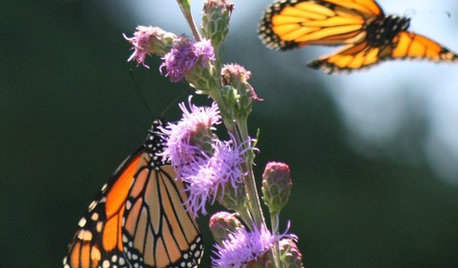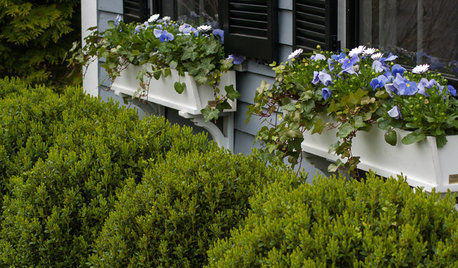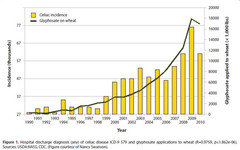Glyphosate/Roundup in Cheerios?! Who Knew?
jrb451
5 years ago
Featured Answer
Sort by:Oldest
Comments (27)
jrb451
5 years agoRelated Discussions
glyphosate info, Is it true?
Comments (34)I don't think personal insults are necessary here. I didn't say glyphosphate has directly killed or even harmed anyone. I was using that statement as an example of flawed logic. Anecdotal "evidence", either for or against something, does not do a whole lot for me. On the other hand, I also am skeptical of "scientific" studies, since somebody had to fund it, and that person or group likely had something to gain or lose from the endeavor. No doubt glyphosphate can kill weeds more cheaply than alternative methods, at least in the short term. But it is also possible that there are longer term effects that we have yet to fully discover or understand. When someone says, "it's worked for person A for X years," in my opinion it does little to negate that possibility. The environmental lobby no doubt hates Monsanto and will do all it can to discredit them, and no doubt Monsanto will accentuate the positive, and leave out the negatives, since they are driven by profit. The truth is somewhere in between. The motives of anyone who takes an extreme position on either side should be questioned....See Moreajuga ground cover growing in lawn....Roundup?
Comments (23)Sounds encouraging. I'd read some mixed reports on the effectiveness of 2,4-D (alone) against Ajuga, but (possibly) better results with a 3-way product, which Killex is (2,4-D, Mecoprop-P, Dicamba) http://forums2.gardenweb.com/forums/load/lawns/msg0918365630041.html http://www.lawnsite.com/showthread.php?t=276043 So, it will be interesting to see your results. Yes, you are right Killex is available (at Canadian Tire), but only in British Columbia, Alberta & Manitoba. You are in BC, right? I'm in QC...sigh. Kind of farcical really, this provincial herbicide 'ban', when commercial lawn care companies can readily get the stuff (and political parties also). At least a third of the residents on my estate have their lawns sprayed....whether they really need it or not. I reckon the previous owner of my house was one and that chemical-dependency was at least part of the reason for my lawn problems....all those dormant seeds. That's my excuse anyway. Anyhow, I'll persist with the Roundup (no other choice now). Whilst slow (it's been about 2 1/2 weeks) it does appear to be working. Probably would have been quicker if I'd sprayed affected areas, rather than leaf-painted, from the start. Seems kind of counter-intuitive to water the weeds, but keeping the treated areas moist definitely helps. So, at the current rate of progress I'm still hoping that I'll be able to over-seed by mid-September. The thing that concerns me though is the sheer number and variety of weeds that are still coming up. Sure, the best natural weed-defense is a thick turf, but I'm beginning to think that I really do need to tackle at least the perennial broad-leafs, and if possible the dense carpets of crabgrass, which are now starting to turn to seed. The white clover that is taking over some areas I can live with. In fact I'm not averse to the idea of a mixed grass-clover lawn, though I can't speak for the neighbors. But the black medic (yellow trefoil) that is prevalent on my front lawn is less desirable. As someone commented on another forum - organic living is all well and good but sometimes you need a prescription from the doctor. I have inquired whether one the lawn-care firms (the one that acknowledged they use herbicides) might do a one-off spray, but they are only interested in offering a 'full year' maintenance plan. There's no way I could manually pull all of this stuff, as adept as I am with a Weed-Hound, and a lot of it is now partially obscured by crabgrass and clover/black medic. So, I guess I could try the available iron-based Weed-B-Gon, several neighbors look like they are having some success, at least with spot sprayed dandelions, but I think I'd need a bit more than spot treatment. Or else see if I can get hold of some Killex (might come back you). The big question then is how much treatment at this stage would put back fall over-seeding (killing time plus soil residual to consider). Don't really want to wait until Spring, as I'd like to try and get an early start with a pre-emergent then. What to do? This post was edited by WorBry on Tue, Aug 20, 13 at 14:11...See MoreOrganic vs. Round-up regarding surrounding desired plants
Comments (37)JAYK I feel (from my experience in local rose clubs and as the former internet consulting ARS rosarian for scientific studies (or some such title) that gardeners have had problems but they were not in a position to question "no underground spread" and had to assume that it must of been drift in spite of whatever precautions they took (I doublt if most knew about the possibilty of weed root to desired plant root transmission). Apparently Monsanto knew: earlier in this thread I quoted the following from another thread (the You was not you nor I): "You mentioned roses. This has been disputed before on GW but roses have many fine surface roots and weeds with similar roots mixed together with the rose roots, the roots are in contact with each other and translocation of the herbicide can take place. Glyphosate kills roots and all so it can kill the rose. This info was quoted to me a few years ago by a Monsanto representative." The scientific reviewed papers that I cited did not "all" agree that it only happened in exceptional purposes. For example I cited a 2006 paper: "There is a common understanding that the widely used herbicide glyphosate is easily degraded and adsorbed in soils and thus, harmless for use in agriculture. We can demonstrate, however, that this conclusion is wrong and dangerous for farmers because in former risk assessments the behaviour of glyphosate in the rhizosphere was not properly considered." Notice that the scientists, editor, and reviewers approved "wrong and dangerous". In my experience as a scientist I expect that the producers of farm glyphosate products would have immediately assigned their in house scientists and/or commissioned paid research to see if they could produce scientific evidence to disprove the paper. The paper was in 2006, I could not find any such disputing paper (apparently you were not able to either); instead I found a November 2007 published paper that supported it. Yes, there are conditions that favor spread and condition that will inhibit spread. Nature is complex. But to attempt to lump all conditions that favor spread into (the following is a quote from a statement that JAYK made in this thread): "unusual circumstances to create this movement, circumstances that are almost never seen in typical gardens." is in my mind the opposite of the actual situation, home gardens with acidic sandy loam soil are very common (even desired - "In general the best pH value range for soil is approximately 6 or 7 as this is the range in which most nutrients can be readily available" - http://www.gardenstew.com/blog/e3-9-soil-ph-and-its-effect-on-your-garden.html . Home gardens with high phosphate concentration (and acidic pH) are also very common - http://searchwarp.com/swa290149.htm. When scientists talk about sandy loam soil they are not talking about "very, very sandy soil situation" - see JAYK's first post, they are actually talking about a common soil: "Sandy loam topsoil is a material that most farmers are familiar with. Although unusual in urban Houston, it can be found north of town. It can be purchased or trucked in from a sight you are familiar with." It is common for gardeners to use a sandy loam soil mixed with compost" "Most experts find the best soil combines compost with a sandy loam topsoil." The quote is from the same link. H. Kuska comment - please note - compost has an acid increasing effect....See Moreroundup + Cactus/succulents
Comments (3)Be careful with Roundup, especially on cacti. You may not notice any damage for months. In fact your plant may still grow and flower beautifully. But then all of a sudden it can turn yellow and black inside and drop dead. This is because cacti have such SLOW metabolism that if any of the chemical enters the tissues, it will take a very long time before it reaches the roots. Roundup is only biodegradable out in the open air, such as on the soil, where it is broken down naturally. If even the tiniest amount gets inside the plant tissue however, it can remain active for much longer. I've heard of people saying that Roundup is safe on orchids as well. This is nonsense. It still affects them, just a lot more slowly than with other plants. I once knew a nurseryman who would spray Roundup all over his orchids to remove weeds from the pots before selling them. I only found out that he was doing this after I had purchased dozens of plants off him. Every plant I had ever purchased from him had died within 12 months. Roundup can actually produce an initial growth spurt and cause profuse flowering in some plants, after which they go backwards and eventually die....See MoreMichael
5 years agoOklaMoni
5 years agoAnglophilia
5 years agoAnnie Deighnaugh
5 years agomatthias_lang
5 years agoeandhl2
5 years agoUser
5 years agolast modified: 5 years agoMichael
5 years agobleusblue2
5 years agojrb451
5 years ago
Related Stories

GARDENING GUIDESGreat Design Plant: Meadow Blazing Star (Liatris Ligulistylis)
Make fast friends with the monarch butterflies and get a color show too with this adaptable U.S. Midwest native
Full Story
GARDENING GUIDESMake Sure You Read This Before Buying New Plants
Follow these 10 plant-selection tips to avoid buyer’s remorse
Full Story
FARM YOUR YARDHow to Build a Raised Bed for Your Veggies and Plants
Whether you’re farming your parking strip or beautifying your backyard, a planting box you make yourself can come in mighty handy
Full Story



beesneeds